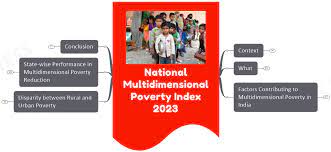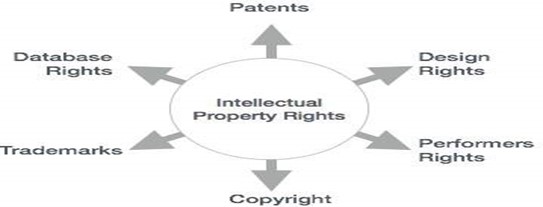NATIONAL MULTIDIMENSIONAL POVERTY INDEX 2023
Why in News:
National Multidimensional Poverty Index: A Progress Review, 2023, released by NITI Aayog recently.
Important Points:
India has registered a remarkable decline of 9.89 percentage points in the number of multidimensionally poor.
This decline took place between 2015-16 and 2019-2021, bringing down the figure from 24.85% to 14.96%.
The report highlights the efforts made to identify and address acute deprivations in health, education, and standard of living using United Nations-approved parameters.
Based on the latest National Family Heath Survey [NFHS-5 (2019-21)], this second edition of the National Multidimensional Poverty Index (MPI) represents India’s progress in reducing multidimensional poverty between the two surveys, NFHS-4 (2015-16) and NFHS-5 (2019-21).
It builds on the Baseline Report of India’s National MPI launched in November 2021. The broad methodology followed is in consonance with the global methodology.
Between 2015-16 and 2019-21, the MPI value has nearly halved from 0.117 to 0.066 and the intensity of poverty has reduced from 47% to 44%, thereby setting India on the path of achieving the SDG Target 1.2 (of reducing multidimensional poverty by at least half) much ahead of the stipulated timeline of 2030.
It demonstrates the Government’s strategic focus on ensuring sustainable and equitable development and eradicating poverty by 2030, thereby adhering to its commitment towards the SDGs.
Decline in Multidimensional Poverty:
The study reveals that approximately 13.5 crore individuals have emerged from multidimensional poverty during the assessment period.
The report emphasizes the use of internationally recognized parameters to identify acute deprivations in health, education, and standard of living.
This approach allows for a comprehensive understanding of poverty that extends beyond income-based measures.
By focusing on various dimensions, such as access to healthcare, quality education, and basic living standards, the report provides a nuanced perspective on poverty eradication.
Regional Disparities:
The report highlights the varying rates of progress in different regions of India.
Rural areas experienced the fastest decline in poverty, with the percentage falling from 59% to 19.28%.
This positive trend can be attributed to the reduction in the number of multidimensionally poor individuals in states like Bihar, Uttar Pradesh, Madhya
Pradesh, Odisha, and Rajasthan. On the other hand, Delhi, Kerala, Goa, and Tamil Nadu, along with the Union Territories, demonstrated the lowest rates of multidimensional poverty.
Bihar, Jharkhand, Meghalaya, Uttar Pradesh, and Madhya Pradesh were identified as the states with the highest percentages of multidimensional poverty.
Urban Progress:
The report also reveals encouraging developments in urban areas. Multidimensional poverty in urban regions decreased from 8.65% to 5.27% during the same assessment period.
Uttar Pradesh emerged as a frontrunner in poverty reduction, with 3.43 crore individuals escaping mul-tidimensional poverty. These findings indicate that efforts to address poverty have been effective across rural as well as urban areas, resulting in tangible improvements in the quality of life for many people.
Initiatives:
The Government's dedicated focus on improving access to sanitation, nutrition, cooking fuel, financial inclusion, drinking water, and electricity has led to significant advancements in these areas.
All 12 parameters of the MPI have shown marked improvements. Flagship programmes like the Poshan Ab-hiyan and Anaemia Mukt Bharat have contributed to reduced deprivations in health. Initiatives such as Swachh Bharat Mission (SBM) and Jal Jeevan Mission (JJM) have improved sanitation across the country.
The impact of these efforts is evident in the swift 21.8 percentage points improvement in sanitation deprivations.
The provision of subsidized cooking fuel through the Pradhan Mantri Ujjwala Yojana (PMUY) has positively transformed lives, with a 14.6 percentage points improvement in cooking fuel deprivations.
Initiatives like Saubhagya, Pradhan Mantri Awas Yojana (PMAY), Pradhan Mantri Jan Dhan Yojana (PMJDY), and Samagra Shiksha have also played a major role in significantly reducing multidimensional poverty in the country.
The remarkable progress achieved through extremely low deprivation rates especially for electricity, access to bank accounts and drinking water, reflects the Government's unwavering commitment to improving citizens' lives and creating a brighter future for all.
Consistent implementation across a diverse set of programmes and initiatives that have strong interlinkages has led to significant reduction in deprivations across multiple indicators.




.jpg)


.jpg)
.jpg)





